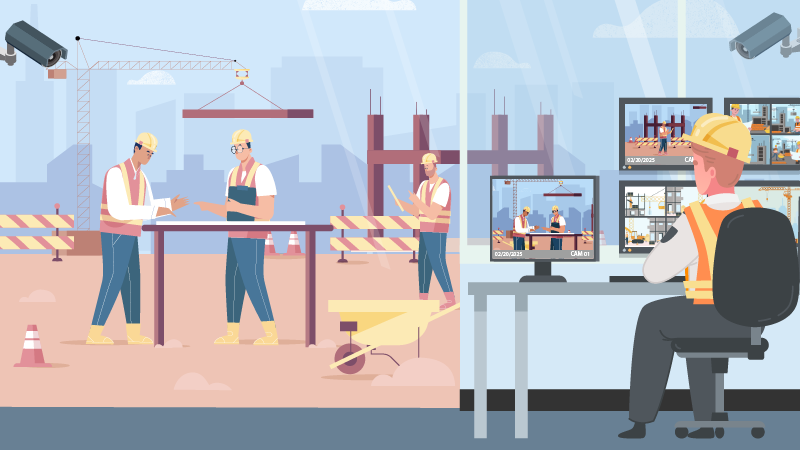


System integrators often operate in challenging environments where continuous video surveillance is essential—not optional. Whether at an emergency entrance, factory control room, or transportation checkpoint, delays in video or failure of hardware can result in safety lapses and operational risk.
Instead of focusing purely on remote feeds or camera placement, today’s integrators must ensure that the monitors deployed on-site are robust, responsive, and optimized for around-the-clock visibility.
In many location-critical sites, the surveillance monitor is the first line of visual defence. Entry gates, security booths, and industrial control rooms require local, always-on video feeds to help personnel react immediately to unexpected events.
Yet these locations are often exposed to harsh physical conditions—dust, light glare, cleaning chemicals, and high human traffic. Standard consumer displays simply don’t meet the durability, clarity, or uptime requirements of such environments.
If you’re exploring how real-time displays improve decision-making at critical sites, check out How Reliable Security Displays Enhance Business Decision-Making.
The global demand for real-time surveillance displays is growing rapidly. According to a 2024 report by Mordor Intelligence, the global video surveillance systems market is expected to grow from USD 54.47 billion in 2024 to USD 90.37 billion by 2029, at a CAGR of 10.59%. This trend reflects the increasing need for real-time surveillance in remote and industrial environments, where system integrators play a critical role in deploying resilient and scalable monitoring solutions.
This growth reflects not only the demand for smarter cameras and AI-powered analytics, but also the need for reliable local displays that support front-line teams at access points, lobbies, or control zones.
Deploying surveillance monitors in remote or mission-critical environments comes with its own set of challenges—and many standard displays simply aren’t up to the task.
One of the most pressing issues is limited real-time visibility. Relying solely on feeds from the control room introduces delays that can impact response times. For entry points, high-security zones, or perimeter fences, on-site staff need access to live camera feeds without lag or interruption. Dedicated monitors installed at these points serve as a first line of defense, allowing security personnel to respond to events the moment they occur.
Another concern is harsh environmental conditions. Dust, humidity, extreme temperatures, and physical impact can easily damage consumer-grade or office monitors. These environments require ruggedized displays built for durability and around-the-clock operation.
System integrators must also navigate compatibility issues. Many facilities still run legacy analog CCTV systems alongside newer IP-based solutions. Integrating displays that can handle both signal types—without expensive converters—is essential for efficient deployment.
Lastly, there’s the issue of maintenance costs. Standard displays not built for continuous use will fail faster, leading to frequent replacements, increased downtime, and rising service costs.
To meet operational and client expectations, system integrators should evaluate surveillance monitors across five key criteria:
Durability is non-negotiable. Look for displays that are resistant to dust, temperature fluctuations, and physical wear. Monitors designed for 24/7 operation—with features like reinforced enclosures, scratch-resistant screens, and sealed internal components—offer greater reliability in remote or industrial settings.
Clarity and consistency are vital. Choose monitors with high-quality color reproduction, strong contrast ratios, and excellent low-light performance—especially since many incidents happen at night. Surveillance-specific image presets (like CCTV modes) help highlight key visual details that might be missed on standard displays.
The ideal monitor should work seamlessly with both legacy and modern surveillance systems. Multi-input compatibility (HDMI, DisplayPort, BNC, VGA) and pass-through functionality enable daisy-chaining and support a wide range of installations without the need for additional hardware.
Time and cost matter. Monitors with flexible mounting options—wall, ceiling, or desktop—allow integrators to adapt to the layout of each site. Features like automatic signal detection, remote display management, and daisy-chaining simplify installation and ongoing operation.
Initial price is just one part of the equation. Choose monitors that are purpose-built for 24/7 use and have protective features like burn-in prevention. These displays offer better ROI over time by reducing replacement frequency, minimizing service visits, and ensuring consistent visual performance.
For further guidance on essential monitor features, refer to our guide on choosing the right security monitor for critical locations.
Investing in professional-grade surveillance monitors offers clear advantages for system integrators and their clients:
As threats become more sophisticated and operations more distributed, the ability to deliver real-time video surveillance is no longer just an added benefit—it’s a baseline expectation. System integrators have a responsibility to provide not just functional solutions, but strategic deployments that address both on-site and centralized monitoring needs.
By selecting robust, purpose-built monitors for critical locations—entry gates, loading zones, restricted areas, and beyond—integrators can enhance safety, reduce costs, and strengthen long-term client relationships. The right monitor, in the right place, can make all the difference.
Explore AG Neovo’s Advanced Security Surveillance Displays, purpose-built for 24/7 performance and protection in location-critical environments.